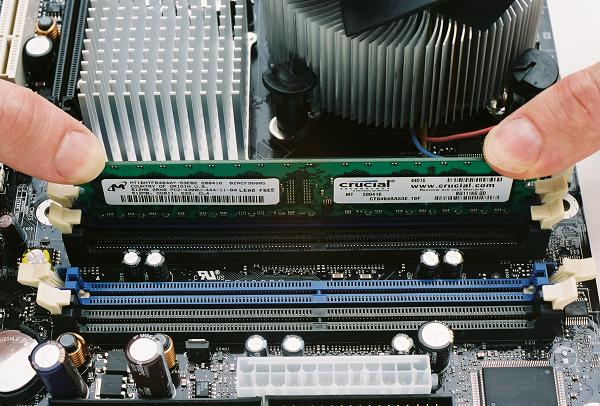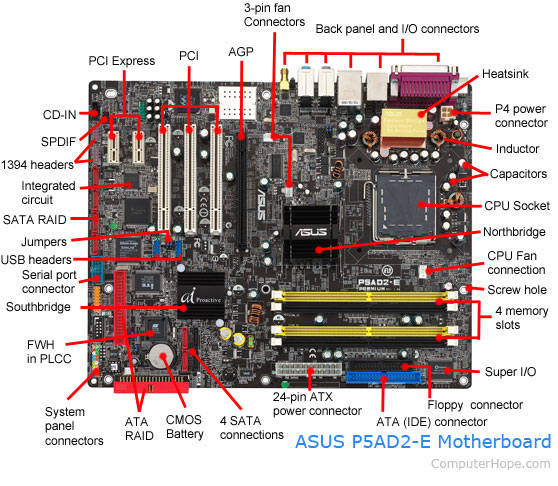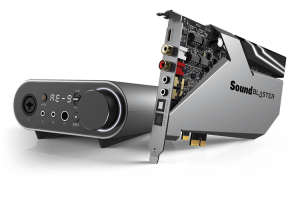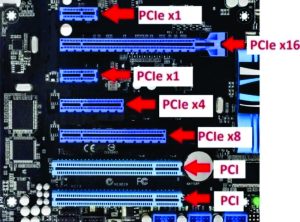What is internal memory and how is it different from external memory?
Computer memory is generally classified as either internal or external memory.
Internal memory, also called “main or primary memory” refers to memory that stores small amounts of data that can be accessed quickly while the computer is running.
External memory, also called “secondary memory” refers to a storage device that can retain or store data persistently. They could be embedded or removable storage devices. Examples include hard disk or solid state drives, USB flash drives, and compact discs.
What are the types of internal memory?
There are basically two kinds of internal memory: ROM and RAM.
ROM stands for read-only memory. It is non-volatile, which means it can retain data even without power. It is used mainly to start or boot up a computer.
Once the operating system is loaded, the computer uses RAM, which stands for random-access memory, which temporarily stores data while the central processing unit (CPU) is executing other tasks. With more RAM on the computer, the less the CPU has to read data from the external or secondary memory (storage device), allowing the computer to run faster. RAM is fast but it is volatile, which means it will not retain data if there is no power. It is therefore important to save data to the storage device before the system is turned off.
What are the types of RAM?
There are two main types of RAM: Dynamic RAM (DRAM) and Static RAM (SRAM).
- DRAM (pronounced DEE-RAM), is widely used as a computer’s main memory. Each DRAM memory cell is made up of a transistor and a capacitor within an integrated circuit, and a data bit is stored in the capacitor. Since transistors always leak a small amount, the capacitors will slowly discharge, causing information stored in it to drain; hence, DRAM has to be refreshed (given a new electronic charge) every few milliseconds to retain data.
- SRAM (pronounced ES-RAM) is made up of four to six transistors. It keeps data in the memory as long as power is supplied to the system unlike DRAM, which has to be refreshed periodically. As such, SRAM is faster but also more expensive, making DRAM the more prevalent memory in computer systems.
What are the common types of DRAM?
- Synchronous DRAM (SDRAM) “synchronizes” the memory speed with CPU clock speed so that the memory controller knows the exact clock cycle when the requested data will be ready. This allows the CPU to perform more instructions at a given time. Typical SDRAM transfers data at speeds up to 133 MHz.
- Rambus DRAM (RDRAM) takes its name after the company that made it, Rambus. It was popular in the early 2000s and was mainly used for video game devices and graphics cards, with transfer speeds up to 1 GHz.
- Double Data Rate SDRAM (DDR SDRAM) is a type of synchronous memory that nearly doubles the bandwidth of a single data rate (SDR) SDRAM running at the same clock frequency by employing a method called “double pumping,” which allows transfer of data on both the rising and falling edges of the clock signal without any increase in clock frequency.
- DDR1 SDRAM has been succeeded by DDR2, DDR3, and most recently, DDR4 SDRAM. Although operating on the same principles, the modules are not backward-compatible. Each generation delivers higher transfer rates and faster performance. The latest DDR4 modules, for example, feature fast transfer rates at 2133/2400/2666and even 3200 MT/s.

What are the types of DRAM packages?
Single In-Line Memory Module (SIMM)
SIMM modules were widely used from the late 1980s to 1990s, and are now obsolete. They typically had 32-bit data bus and were available in two physical types—30- and 72-pin.
Dual In-Line Memory Module (DIMM)
Current memory modules come in DIMMs. “Dual in-line” refers to pins on both sides of the modules. A DIMM originally had a 168-pin connector supporting 64-bit data bus, which is twice the data width of SIMMs. The wider bus means that more data can pass through a DIMM, translating to faster overall performance. Latest DIMMs based on fourth-generation double data rate (DDR4) SDRAM have 288-pin connectors for increased data throughput.
What are the common types of DIMM?
There are several DIMM architectures. Different platforms can accommodate different memory types so it is best to check which modules are supported on the motherboard. Here are the most common standard DIMMs, with a typical length of 133.35 mm and height of 30 mm.
| DIMM Type | Description |
| Unbuffered DIMMs (UDIMMs) | Used mainly on desktop and laptop computers. They run faster and cost less, but are not as stable as registered memory. Commands go directly from the memory controller residing in the CPU to the memory module. |
| Fully buffered DIMMs (FB-DIMMs) | Typically used as main memory in systems requiring large capacities such as servers and workstations, FB-DIMMs use advanced memory buffer (AMB) chips to increase reliability, maintain signal integrity and improve error detection methods to reduce soft errors. The AMB bus is split into a 14-bit read bus and a 10-bit write bus. By having a dedicated read/write bus, reads and writes can happen simultaneously, resulting in increased performance. Lesser pin counts (69 pins per serial channel compared with 240 pins on parallel channels), result in lesser routing complexity and allowing smaller board designs for compact, small form factor systems. |
| Registered DIMMs (RDIMMs) | Also known as “buffered” memory, are often used in servers and other applications requiring stability and robustness. RDIMMs feature onboard memory registers (hence the name “registered”) placed between the memory and memory controller. The memory controller buffers Command, Addressing and Clock Cycling, directing instructions to the dedicated memory registers instead of accessing the DRAM directly. As a result, the instructions could take approximately one CPU cycle longer, but the buffering reduces the strain on the CPU’s memory controller. |
| Load Reduced DIMMs (LR-DIMMs) | Use Isolation Memory Buffer (iMB) technology, which reduces the load on the memory controller by buffering both data and address lanes. Unlike the register on RDIMMs which buffer only Command, Addressing and Clock Cycling, the iMB chip also buffers data signals. The iMB chip isolates all electrical loading including data signals of the DRAM chips on the DIMM from the memory controller, so the memory controller only sees the iMB and not the DRAM chips. The memory buffer then handles all reads and writes to the DRAM chips, boosting both capacity and speed. (Source: Isolation Memory Buffer) |
Aside from standard-size DIMMs, are there small form factor DIMMs for space-constrained systems?
Small outline DIMMs (SO-DIMMs) are the smaller alternatives to DIMMs. While the standard DDR4 DIMM is about 133.35 mm in length, SO-DIMMs are just about half the size of regular DIMMs at 69.6 mm long, making them ideal for ultra-portable devices. Both commonly have a height of 30 mm but may be available in very low profile (VLP) format at 20.3 mm tall or ultra-low profile (ULP) at 17.8 to 18.2 mm. Another type of small form factor DIMM is the Mini-RDIMM, which has a length of only 82 mm compared with 133 mm of regular RDIMMs.
ATP DRAM Products
ATP offers industrial memory modules in different architectures, capacities and form factors. ATP DRAM modules are commonly used in industrial PCs and embedded systems. Resistant against vibration, shock, dust and other challenging conditions, ATP DRAM modules perform well even under the most demanding workloads and applications, as well as in different operating environments.
Committed to product longevity, ATP also continues to offer legacy DRAM modules in select form factors under its license agreement with Micron Technology, Inc. For information on ATP’s legacy SDRAM products, visit Legacy SDRAM.
To ensure high reliability, ATP conducts thorough testing and validation from IC level up to module and product levels using Automatic Testing Equipment (ATE) for various electrical parameters such as marginal voltage, signal frequency, clock, command timing and data timing under continuous thermal cycles. Test During Burn-In (TDBI) employs a special mini thermal chamber where modules are subjected to low and elevated thermal tests to screen out defective components and minimize IC infant mortality, thus ensuring higher production quality and reducing actual field failures.
The table below shows ATP’s DDR4 DRAM products.


RDIMM ECC Very Low Profile (VLP): 133.35 x 18.75

UDIMM ECC 133.35 x 31.25
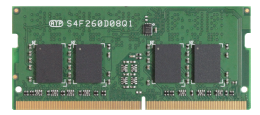
SO-DIMM ECC 69.6 x 30

Mini-DIMM
Unbuffered ECC Very Low Profile (VLP): 80 x 18.75
The table below shows a size comparison among different types of DRAM modules.
| DIMM Type | Size (L x H mm) | |
| DDR4 | Standard | 133.35 x 31.25 |
| VLP (Very Low Profile) | 133.35 x 18.75 | |
| DDR3 | Standard | 133.35 x 30 |
| VLP | 133.35 x 18.28 to 18.79 | |
| ULP (Ultra-Low Profile) | 133.35 x 17.78 to 18.28 | |
| DDR2 | Standard | 133.35 x 30 |
| VLP | 133.35 x 18.28 to 18.79 | |
| DDR | Standard | 133.35 x 30 |
| VLP | 133.35 x 18.28 to 18.79 | |
| SDRAM | Standard | 133.35 x 25.4 to 43.18 |
Single In-Line Memory Modules (SIMM) is that the little circuit boards having notches wherever the RAM chips are fixed. SIMM connectors and therefore the slot situated on the motherboard are created of metal(gold or tin). In SIMM, Pins present in either facet are connected. There are two type of SIMM presents, one with 30 pins and another one is with 72 pins.
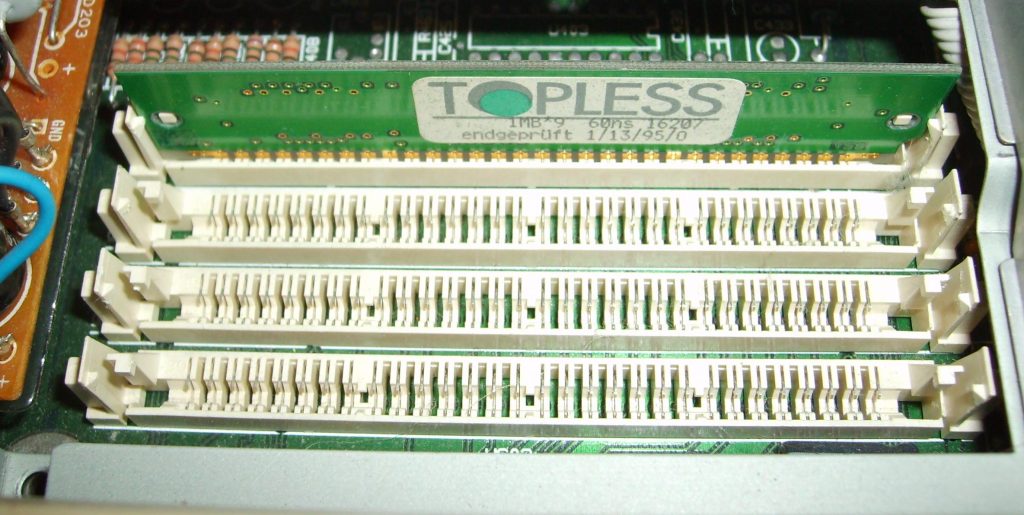
Dual In-Line Memory Module (DIMM), additionally has metal connectors almost like SIMM, however either of the perimeters of the connective doesn’t admit the opposite. DIMM supports 64 bit channel for data transferring while SIMM supports only maximum of 32 bit channel. There are three type of DIMM presents which are used by modern motherboard, one with 168 pins and second one is with 184 pins and third one is 240 pins.
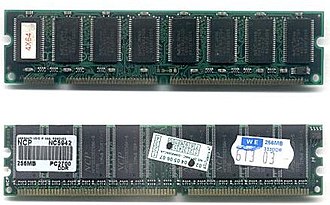
DIMM & DDR RAM

DDR RAM | Types of DDR RAM
DDR RAM ( Double Data Rate ) is the advance version of SDRAM (Synchronous Dynamic Random-Access Memory).
DDR is a very fast computer memory that transfers data on both the rising and falling edges twice as fast as compared to SDRAM chips.
Due to the different use of the clock signal, DDR RAM is capable of transfer twice at the same time.
There are five types of DDR SDRAM is given below.
- DDR1 SDRAM
- DDR2 SDRAM
- DDR3 SDRAM
- DDR4 SDRAM
- DDR5 SDRAM
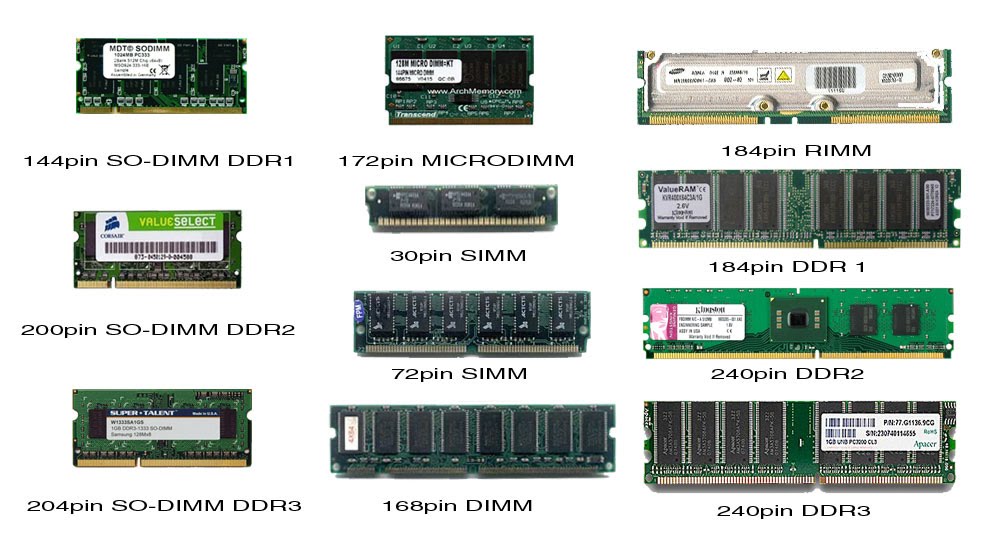
1.) DDR1 SDRAM
DDR RAM ( Double Data Rate ) is the advance version of SDRAM (Synchronous Dynamic Random-Access Memory).
All Detail About DDR1
- Developer – Samsung
- Type – SDRAM
- Release date – 1998
- Voltage – 2.5 to 2.6 Volt
- Clock Rates – 100 to 200 MHz
2.) DDR2 SDRAM
DDR2 RAM also transfers data twice at the same time. But DDR2 is capable of transferring data faster than DDR1.
Because the upgrade version of DDR1 is DDR2.
All Detail About DDR2
- Developer – Samsung JEDEC
- Type – SDRAM
- Generation – 2nd Generation
- Release date – 2003
- Voltage – 1.8 to 1.55 Volt
- Clock rate – 100 to 266 MHz
- Cycle time – 10 to 3.75 ns
- Bus clock rate – 200 to 533 MHz
- Transfer rate – 400 to 1066 MT/s
3.) DDR3 SDRAM
DDR3 RAM also transfers data twice at the same time. But DDR3, is capable of transferring data faster than DDR2 and DDR1.
Because the upgrade version of DDR1 and DDR2 is DDR3.
All Detail About DDR3
- Developer – JEDEC
- Type – SDRAM
- Generation – 3rd Generation
- Release date – 2007
- Voltage – 1.5 to 1.35 Volt
- Clock rate – 400 to 1066 MHz
- Transfer rate – 800 to 2133 MT/s
4.) DDR4 SDRAM
DDR4 RAM also transfers data twice at the same time with high bandwidth. But DDR4, is more capable of transferring data faster than DDR1, DDR2 and DDR3.
Because the upgrade version of DDR1, DDR2 and DDR3 is DDR4.
All Detail About DDR4
- Developer – JEDEC
- Type – SDRAM
- Generation – 4th Generation
- Release date – 2014
- Voltage – 1.2 Volt
- Clock rate – 800 to 1600 MHz
5.) DDR5 SDRAM
DDR5 RAM also transfers data twice at the same time with high bandwidth. But DDR5, is more capable of transferring data faster than DDR1, DDR2, DDR3 and DDR4.
Because the upgrade version of DDR1, DDR2, DDR3 and DDR4 is DDR5.
